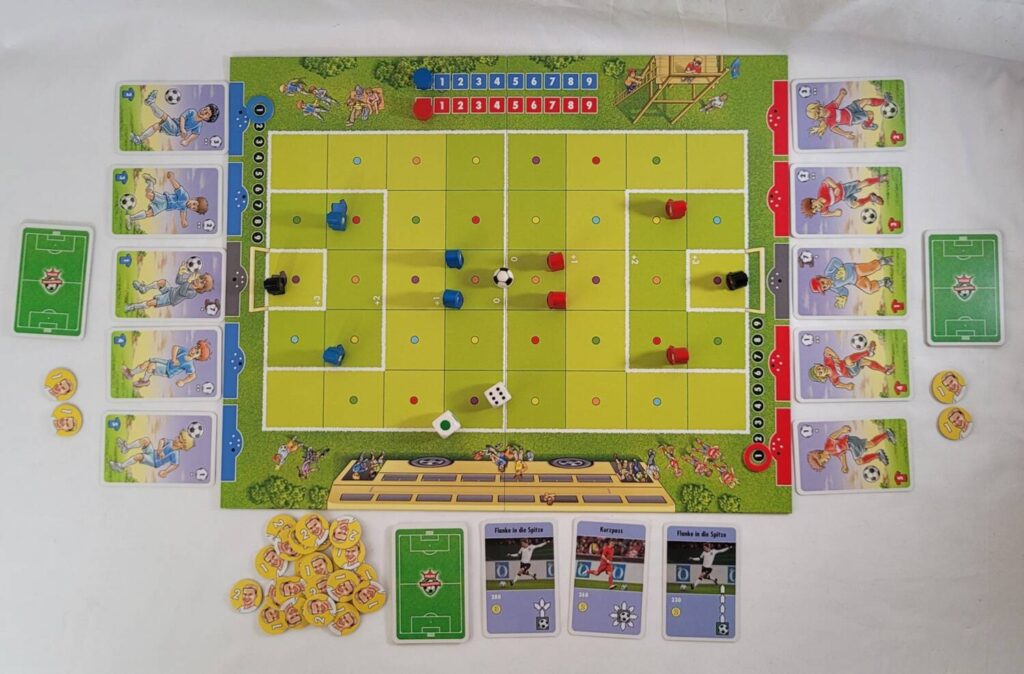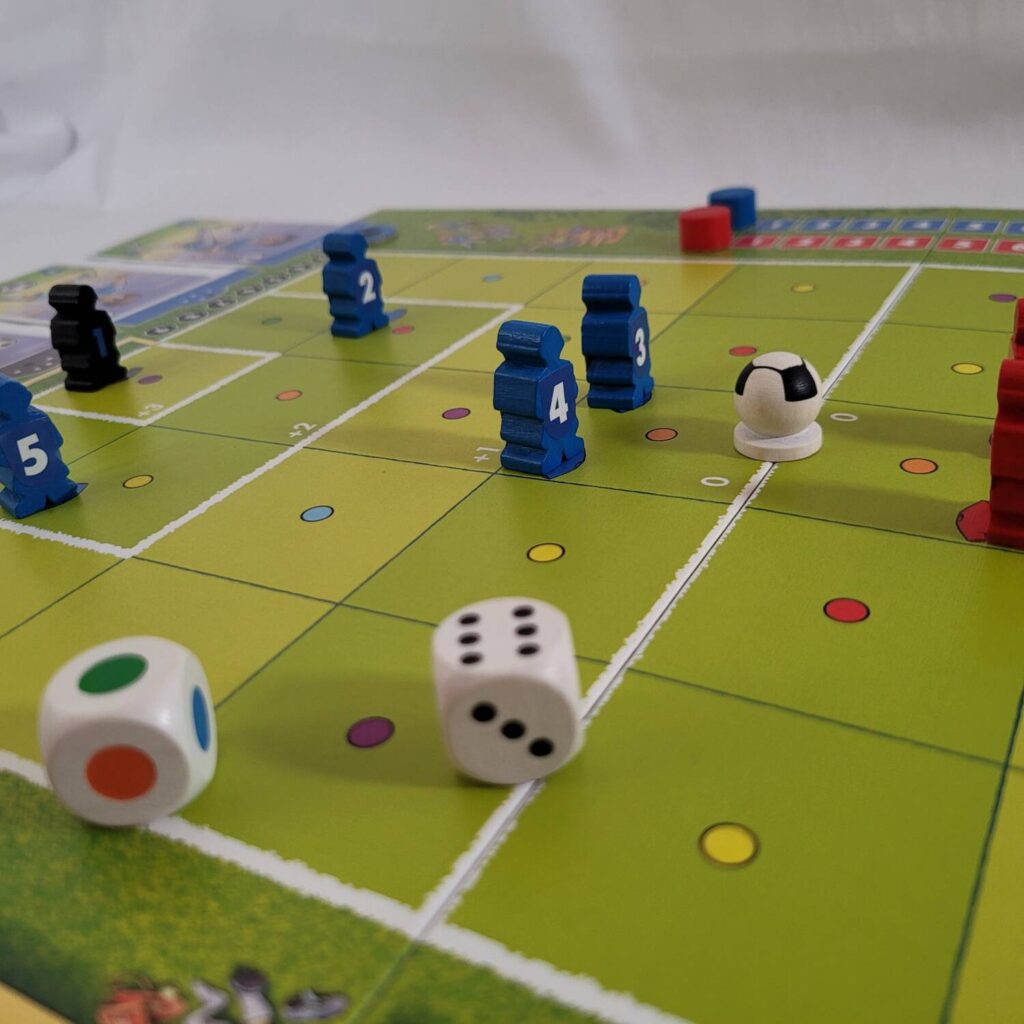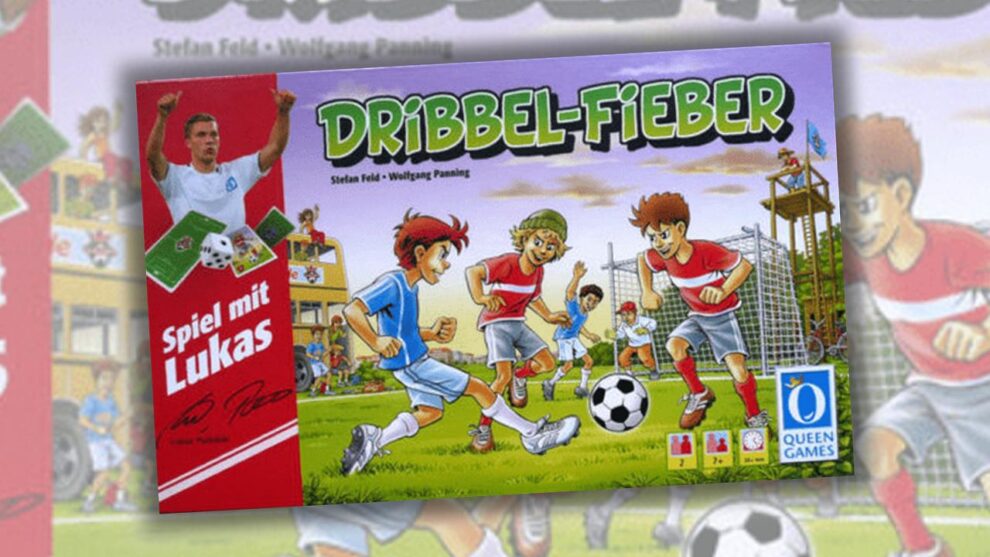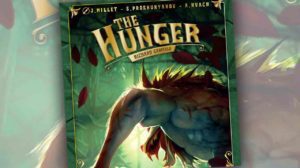Hello and welcome to ‘Focused on Feld’. In my Focused on Feld series of reviews, I am working my way through Stefan Feld’s entire catalogue. Over the years, I have hunted down and collected every title he has ever put out. Needless to say, I’m a fan of his work. I’m such a fan, in fact, that when I noticed there were no active Stefan Feld fan groups on Facebook, I created one of my own.
Today we’re going to talk about 2010’s Spiel mit Lukas: Dribbel-Fieber, his 11th game. One of two games in Queen Games’ Spiel mit Lukas line of games, Dribbel-Fieber was Stefan Feld’s very first and, so far, only co-design (co-designed with Wolfgang Panning).
From the moment that I latched onto Stefan Feld as a designer who I wanted to collect, I knew there were two titles that it was going to be next to impossible for me to obtain. The first, Strasbourg, was long out of print and apparently so good that nobody wanted to let go of it. The second was Spiel mit Lukas: Dribbel-Fieber (or, simply, Dribbel-Fieber for short), a game that didn’t see a large print run, was only available in German, was long out of print, and was highly sought after for its rarity. I had a good feeling that, given enough time, I could get my hands on a copy of Strasbourg. Finding a copy of Dribbel-Fieber, on the other hand, seemed like something forever out of reach.
And then one day I was putzing around on Amazon.de and found it, and it was only 30 euros! I couldn’t believe my eyes. Had I really just found my unicorn? Was this really real? There was only one way to find out. Without hesitation, I added it to my cart and almost immediately ran into problems. Bringing home a unicorn, as it turns out, isn’t easy.
The problem was that the seller wouldn’t ship to the United States, no matter how hard I begged and pleaded. “Germany only” was their mantra, and they weren’t budging. But, not being the kind of person to take ‘no’ for an answer, I kept hammering away at them until I got them to begrudgingly agree to ship to Europe, provided I could locate a recipient, and provided I foot the bill for the extra expenditure.
Thus would begin a long search for someone not only willing to receive the game in my name, but to also agree to repackage it and then ship it to me half a world away. Thankfully, I had a friend who lived in England who not only agreed to help me out, but was excited to do so. Needless to say, that 30 euro dream game quickly turned into a 100+ euro nightmare. But, the end result was that I now owned a much coveted, much prized copy of Dribbel-Fieber—and also a jar of Marmite that my friend sent to me as well. While I have derived much joy from the former, I can’t say the same for the latter. If Marmite is an acquired taste, I shudder at the thought of everything I’d have to go through to acquire it. It… was not pleasant.
Overview
From Wikipedia: “Lukas Josef Podolski (German: [ˈluːkas poˈdɔlskiː]; born Łukasz Józef Podolski, Polish: [ˈwukaʂ pɔˈdɔlskʲi], on 4 June 1985) is a professional footballer who plays as a forward or attacking midfielder for Ekstraklasa club Górnik Zabrze.”
If any of that meant something to you, no doubt you are a fan of football (or as we Americans like to call it, soccer). I don’t claim to know anything about soccer or Lukas Podolski. In fact, prior to having actually received this game in the mail and opening it for the first time, I’d never even heard of him. When it comes to soccer and the trivia surrounding it, I am less than a neophyte. The extent of my knowledge comes from firsthand experience when I played for a couple of seasons on a team in Memphis around 40 years ago, which is to say, almost non-existent.
But, what I do know is Stefan Feld. And what I know about Dribbel-Fieber is that it is one of the most charming games I have ever played and likely ever will.
Dribbel-Fieber is a deck-building game about a group of young kids playing their favorite game at their local pitch. Like many deck-building games, the players begin the game with matching sets of cards. Over time, though, inspired by their hero Lukas “Poldi” Poldoski, the young athletes dig down deep and find within themselves the beating hearts of champions. Their basic moves become inspired, and their skill grows.
Inside of the box are two versions of the game—the introductory Kick’n’Run game as well as the Champion Version. While it’s not entirely necessary to have played one to play the other, the Champion Version builds upon the concepts of the Kick’n’Run game.
Kick’N’Run Version
Setup
To set up for Kick’N’Run, lay out the game board. Then, give each player the deck of Action cards, the score marker, the shot value ring, and wooden figures in their chosen color. The player cards are arranged along the edge of each player’s side of the game board. The goalie will always go into the middle spot. The other cards can be placed in whichever way the player wishes. Each spot corresponds to a field position, and each card corresponds to a specific wooden figure. The wooden figures begin the game in the marked spots. The shot value rings are placed onto the 0 spaces just above the card layouts. The score markers begin on the 0 of the score tracks, and the wooden soccer ball begins in the center of the pitch.

Next, the blue and yellow Poldi-cards are shuffled to form a deck, which is placed face down next to the game board. Three of these are drawn and placed face up in a row to form a supply. Each player receives two Polditalers (coins). The rest are set aside into a general supply. Each player draws three Action cards into their hand from their respective decks, the referee coin is flipped to determine who goes first, and the game begins.
Phases
Each round of the game is played over a series of four phases: card-less play, play cards, draw cards, and shot at goal. In the card-less play phase, if the attacking (i.e. – active) player is not in possession of the ball, then they may move their player figure who is closest to the ball onto the same space as the ball. If they are in possession, then they receive some free movement for one of their player figures.
In the play cards phase, the attacking player may play as many cards from their hand as they wish, in any order they wish. Playing cards is how you’ll jockey for position to take shots on goal, but you can also discard cards to gain two Polditalers for each card that you choose to discard in this way. Polditalers are used in the next phase, the draw cards phase.

In the draw cards phase, the player may optionally purchase one of the cards from the Poldi-card lineup. Blue cards go directly to the player’s hand while yellow cards remain in play in front of the player where they will wait until the player decides to discard them for their provided benefit. Then, the player draws cards until they have a total of three cards in hand.
If a player does not buy a Poldi-card, then the card with the highest number printed on it is removed from the game and another is drawn and placed into the lineup as a replacement. The deck from which players will be purchasing cards also functions as the game’s timer. When the deck runs out, the game ends, and the player who has scored the most goals wins the game.

In the shot at goal phase, the attacking player will have the opportunity to try to score a goal. If the ball is on the opposing player’s side of the board, the attacking player will have the opportunity to take a shot, or they may be forced to take one if the ball is in the same spot as one of the attacking player’s figures, and it is in the area directly in front of the opposing player’s goal. If the ball is still on the attacking player’s side of the board, then no shot may be taken and play passes to the other player.
When taking a shot at goal, a die is rolled to determine whether or not you were successful. To determine the target number for success, several things need to be taken into account: the attack value of the shooting figure (different figures have different values printed on their cards), the proximity to the goal (the closer you are to the goal, the better), and any bonuses gained from the yellow Volley cards the player may have purchased. The values of all these are added together to come up with your attack value. Subtract this from the Defense value of the goalkeeper (based on the goalkeeper’s position) and any bonus defense from defending figures which may be in the same space as the ball. The remainder is your target number. Use your shot value ring to mark it.
Now, roll the 6-sided die. If you exceed your target number, you have scored a goal. All players return their figures to their starting positions and play continues starting with the next player. If the roll was equal to your target, a bounceback occurs. The defending player rolls the goalkeeper die to determine which space surrounding the goal the ball is returned to. If there is an opposing player’s piece there, this will result in another attempt on goal. Otherwise, play continues as normal, beginning with the next player. If the roll was lower than the target, a bounceback occurs, but this time the goalkeeper can place the ball into any of the spaces matching the color on the goalkeeper die.
Champion Version
Changes
During setup, several new red Poldi-cards are shuffled into the deck (these can be used during your opponent’s turn) along with two Whistle cards (a halftime whistle and a final whistle). When the halftime whistle shows up, there is a momentary pause in the game where players are allowed to trim their deck, removing unwanted cards from the game. The final whistle card brings the game to an end. Also, in the card-less play phase, the attacking player may move one of their figures, followed by the defending player, followed by the attacking player again.
But, these are not the only changes. Unlike the Kick’N’Run version, where you’ve got no say in what happens to you when it isn’t actively your turn, the Champion version gives you some measure of say-so. In addition to the number printed on a figure (and its matching card in the form of a small t-shirt in the lower left corner) being a way to identify it, this number also functions as its ‘dueling strength’. With the exception of the blue and yellow Poldi-cards, each card in the game features one of these t-shirt icons with a number inside of it as well.
Instead of the possession of the ball automatically transferring to the attacking player like in the Kick’N’Run version, in the Champion version, the dueling strength of any figures in the same square as the ball are compared to determine who has control of the ball, with ties in favor of the attacking player. Now, rather than being able to just plow through another player’s figures, a dueling strength battle takes place to determine whether you’re able to push them out of the way. And, instead of playing a card for its ability, it can be discarded to boost your figure’s dueling strength temporarily by the amount shown on the discarded card. This boost in power lasts until it’s the attacking player’s turn again, which means that you’re not only boosting your figures’ attack power, but you’re also boosting their defense during your opponent’s next turn as well.
Thoughts
If Dribbel-Fieber has taught me one thing, it’s this: a game’s rarity does not necessarily correspond to how good the game actually is. You see, despite its rarity, Dribbel-Fieber is not a great game. Is this the result of the game being a co-design, or is it the result of the game being a weird, soccer-related marketing ploy? Maybe it’s some mixture of the two. If it weren’t for the fact that Stefan Feld had previously published such classics as Notre Dame, In the Year of the Dragon, The Name of the Rose, and Macao, I could chalk it up to Feld still being a relatively new designer at the time—his first game was released just five years earlier in 2005. So, that’s not it.

The general atmosphere of Dribbel-Fieber is that it is a game that’s targeted at a younger audience. If that’s the case, it explains a lot. It explains why so much of your success, or lack thereof, is tied to random dice rolls that are backed up by random card draws. I don’t mind randomness in my games provided I have some agency over that randomness by means of being able to adjust those results in some fashion, but nothing like that is provided in Dribbel-Fieber. Instead, the flow of the game basically comes down to drawing your cards and hoping for the best, trying to get one of your figures across the line with the ball in their possession, and then rolling the die and hoping for the best again. The player that gets the luckiest in these regards is going to win the game.
This is true for both the Kick’N’Run as well as the Champion versions. Although, if you’re going to play Dribbel-Fieber at all, the Champion version is the way to go because you at least have an opportunity to cleanse your deck of useless cards at some point.
In the end, though, despite its heavy reliance on luck, Dribbel-Fieber is still an enjoyable game if you go into it with the right mindset. As a pleasant excursion with my work buddy over lunch, Dribbel-Fieber’s not a bad choice. The playtime is quick and the decision space is limited. Turns are uncomplicated and the end goal is clearly spelled out. As the main event at game night, though, not so much. When I go to game night, I want to play games that are going to grab me and keep me interested. I want to play games that test my mental mettle, and Dribbel-Fieber doesn’t even come close to fitting that bill.
I love the theme, and I love the idea of a group of scrappy neighborhood kids playing soccer on their makeshift pitch and getting excited about, and inspired by, the latest exploits of their hero. It’s got a very Sandlot feel about it. However, despite its rustic charm, I have a hard time recommending this one. For the average gamer, Dribbel-Fieber is a title you can ignore. There are plenty of other, better, two-player games out there. For a die-hard Feldie, on the other hand? Do you need to even ask?










